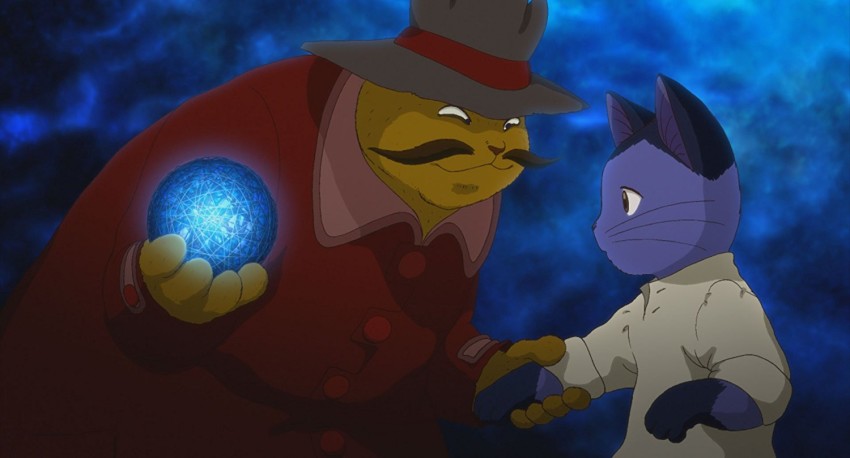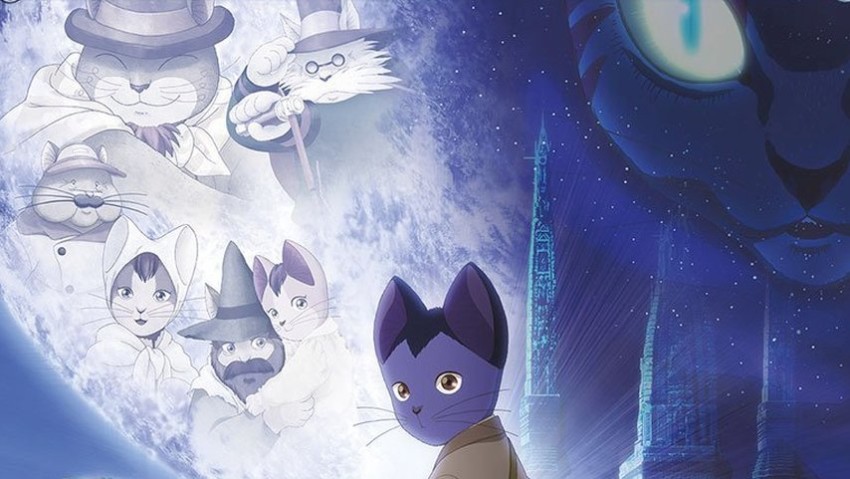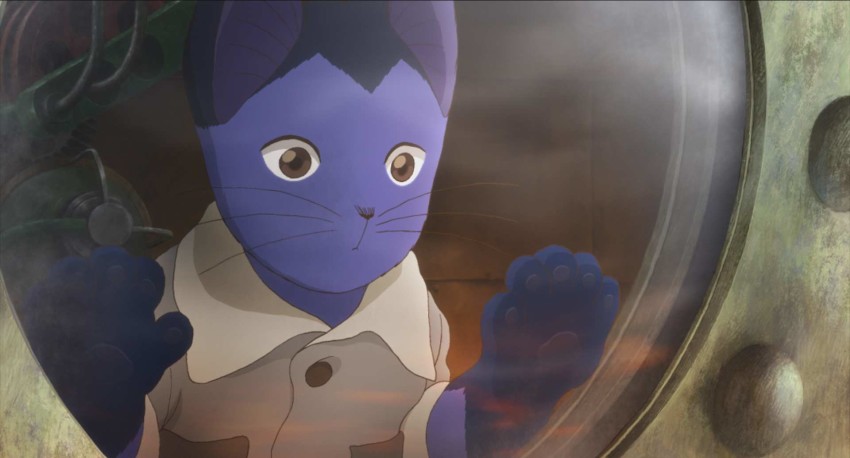The Trouble with Budori Gusuco
September 9, 2019 · 0 comments
By Jonathan Clements.
 It is difficult to overstate the impact of the author Kenji Miyazawa (1896-1933) on Japanese literature, and anime. He was still in his thirties when he died, a largely unknown poet living in provincial obscurity, and only really read outside local newspapers after the publication of a Complete Works a decade later. In the post-war period, which saw most of the Japanese school curriculum bleached and purged of any authors with wartime associations, Miyazawa’s gentle, pastoral tales, suffused with Buddhist imagery, swiftly took root, becoming the set books of an entire generation of schoolchildren.
It is difficult to overstate the impact of the author Kenji Miyazawa (1896-1933) on Japanese literature, and anime. He was still in his thirties when he died, a largely unknown poet living in provincial obscurity, and only really read outside local newspapers after the publication of a Complete Works a decade later. In the post-war period, which saw most of the Japanese school curriculum bleached and purged of any authors with wartime associations, Miyazawa’s gentle, pastoral tales, suffused with Buddhist imagery, swiftly took root, becoming the set books of an entire generation of schoolchildren.
Their impact can be felt even as far away as Scotland, where the last ten years at Scotland Loves Anime have seen many allusions to Miyazawa’s work. His allegory of death and the afterlife, Night on the Galactic Railroad, was excerpted in fantasy sequences in the 2014 award-winner Giovanni’s Island, and was plainly a huge influence on Keiichi Hara’s Colorful. Moreover, Miyazawa’s loving depictions of his beloved homeland in Iwate prefecture, all mist-clad mountain forests and wind-blown cliff-tops, would become a major influence on the work of Sachiko Kawashiba, whose Birthday Wonderland is also playing at this year’s festival.
Miyazawa also wrote The Life of Budori Gusuco, an anime adaptation of which played in competition at Scotland Loves Anime in 2013, luring in an audience of previously unseen faces, with many punters showing up from the Japanese Buddhist community. The film failed to secure any love from the festival jury, which itself has turned it into something of a legend. It is being shown again this year, partly to assuage repeated audience demands to know if it really was all that weird. But animating Budori Gusuco was regarded as a difficult and problematic task even by its director, Gisaburo Sugii.
When Sugii previously worked on his much-loved Night on the Galactic Railway (1985), he was working to a notoriously flexible text. Although Miyazawa had worked on the original manuscript for a decade, the story was never published during the author’s lifetime, and only appeared in a posthumous Collected Works… and then another, and another, until four variant texts were on the market, each of them interpolating different scenes and sometimes even new characters. Such confusion about the story that Miyazawa would have told, had he got around to finishing it, gave Sugii a degree of leeway in interpreting the story.
When first offered the directing job on Night on the Galactic Railroad, Sugii turned the job down, unable to see how he could turn Miyazawa’s deliberately abstract text into something concrete enough to film. It was the manga artist Hiroshi Masumura who came up with a solution – keeping the original abstraction in the anime by making the lead characters cats. This simple decision would have an arguably disruptive effect on the reception of Kenji Miyazawa’s work in other media ever since – after Night on the Galactic Railroad, both Budori Gusuco and the Miyazawa biopic Spring and Chaos would also use anthropomorphised cats, leading many casual viewers to assume that such imagery was present in Miyazawa’s original work, and that he was “the cat guy.”
 As a director deeply invested in conveying human emotions through animation, Sugii found in Miyazawa’s works a surprisingly blank canvas. “Miyazawa’s tales,” wrote Sugii in a 2012 memoir, “give the impression that they have a message to impart, but only a few actually do. The characteristic of his stories is that they state simple facts, such as what happened, but in some extreme cases, they do not even reveal how the protagonist feels from scene to scene. Why does he only depict phenomena? […] The more parts there are to leave the readers to interpret, the more will the story be interpreted to suit the time at which it is read.” For Sugii, this ambiguity was the key to Miyazawa’s long-term success as a children’s classic.
As a director deeply invested in conveying human emotions through animation, Sugii found in Miyazawa’s works a surprisingly blank canvas. “Miyazawa’s tales,” wrote Sugii in a 2012 memoir, “give the impression that they have a message to impart, but only a few actually do. The characteristic of his stories is that they state simple facts, such as what happened, but in some extreme cases, they do not even reveal how the protagonist feels from scene to scene. Why does he only depict phenomena? […] The more parts there are to leave the readers to interpret, the more will the story be interpreted to suit the time at which it is read.” For Sugii, this ambiguity was the key to Miyazawa’s long-term success as a children’s classic.
Budori Gusuco, however, was one of the few Miyazawa stories to be actually published in Miyazawa’s lifetime, appearing in 1932 in the magazine Jido Bungaku (Children’s Literature). The story was hence fixed… at least in part, although Sugii had his doubts, pointing to elements of the story that seemed to be left-overs from previous drafts that he was sure Miyazawa would have dropped or elaborated on, had he not died so soon after the story’s first appearance.
Sugii identified three “sticky points” with turning Budori Gusuco into a film – the science, the drama and the element of self-sacrifice. Scientifically, he had issues with the story’s grand finale, in which Budori blows up a volcano in order to release tons of carbon dioxide into the air, trapping heat beneath a greenhouse effect, and saving the people of Iwate. The idea of finishing with a celebration of a massive carbon footprint would hardly appeal to modern audiences, but Sugii was not even sure about the science. “It’s widely known,” he pointed out, “that far from raising the temperature, a volcanic eruption would lower it, as the volcanic ash in the air would block the sun.”
He found himself a volcanologist, Setsuya Nakata, prepared to offer him a somewhat hand-wavy explanation, that the nature of Carbonado mountain derived from carbonatite in its rocks, which meant it would release a lot more carbon dioxide than a normal volcano. Although that solved one problem for Sugii, the idea that humans would actually cause a volcano to erupt still left him uneasy. Seemingly less of an issue when the film was first in development, the idea came to trouble Sugii substantially more by the time it was released in 2012, the year after the Tohoku earthquake, tsunami and nuclear disaster. “Nothing is more dangerous than the idea that the humans can control anything with science,” wrote Sugii, fretting that his film’s supreme confidence in human ingenuity would look lamentably old-fashioned in post-Tohoku Japan.
 Sugii also wrestled with the problem of depicting the disappearance of Budori Gusuco’s sister Neri. In the original story, she is kidnapped, or at least that is how the young Budori remembers it. Sugii regarded the story of Neri’s disappearance as a subplot within the famine – a semi-mythologised memory on Budori’s part of his sister being sold in a time of extreme food shortage. Famine, in Budori Gusuco, is not simply a food crisis to be managed, but interpreted by Sugii as literally the end of Budori’s world, an idea that gave him more material to use in the film’s ending, in order to justify the extreme acts that Budori is prepared to take.
Sugii also wrestled with the problem of depicting the disappearance of Budori Gusuco’s sister Neri. In the original story, she is kidnapped, or at least that is how the young Budori remembers it. Sugii regarded the story of Neri’s disappearance as a subplot within the famine – a semi-mythologised memory on Budori’s part of his sister being sold in a time of extreme food shortage. Famine, in Budori Gusuco, is not simply a food crisis to be managed, but interpreted by Sugii as literally the end of Budori’s world, an idea that gave him more material to use in the film’s ending, in order to justify the extreme acts that Budori is prepared to take.
Despite her absence from much of the story, Neri is a crucial character for understanding the world of Kenji Miyazawa. She stands in for the author’s real-life sister, Toshi, who died in 1922. The grief-stricken Miyazawa, aged 26, took a long journey by train to the far north of Japan (in fact, to Sakhalin island, now part of Russia). He would spend much of the rest of his life fashioning and refashioning a tale of youthful bereavement, in multiple drafts that would ultimately turn into Night on the Galactic Railroad, and The Legend of Nenemu Pennennennen, the fore-runner of Budori Gusuco.
For Sugii, the real takeaway from Budori Gusuco was the way in which the world of the human characters, despite all their scientific efforts, was dominated by climate change and volcanic activity. “Neither of them are desirable to us and both of them are menaces of nature that are beyond our control,” he wrote. “However, cold weather and volcanic activities are there as a part of the nature, away from human activities in the first place. How should the humans react to a nature that exists beyond our control? I think we are living in times when we really ought to think about that.”
The Life of Budori Gusuco is screening once more at this year’s Scotland Loves Anime.
Leave a Reply